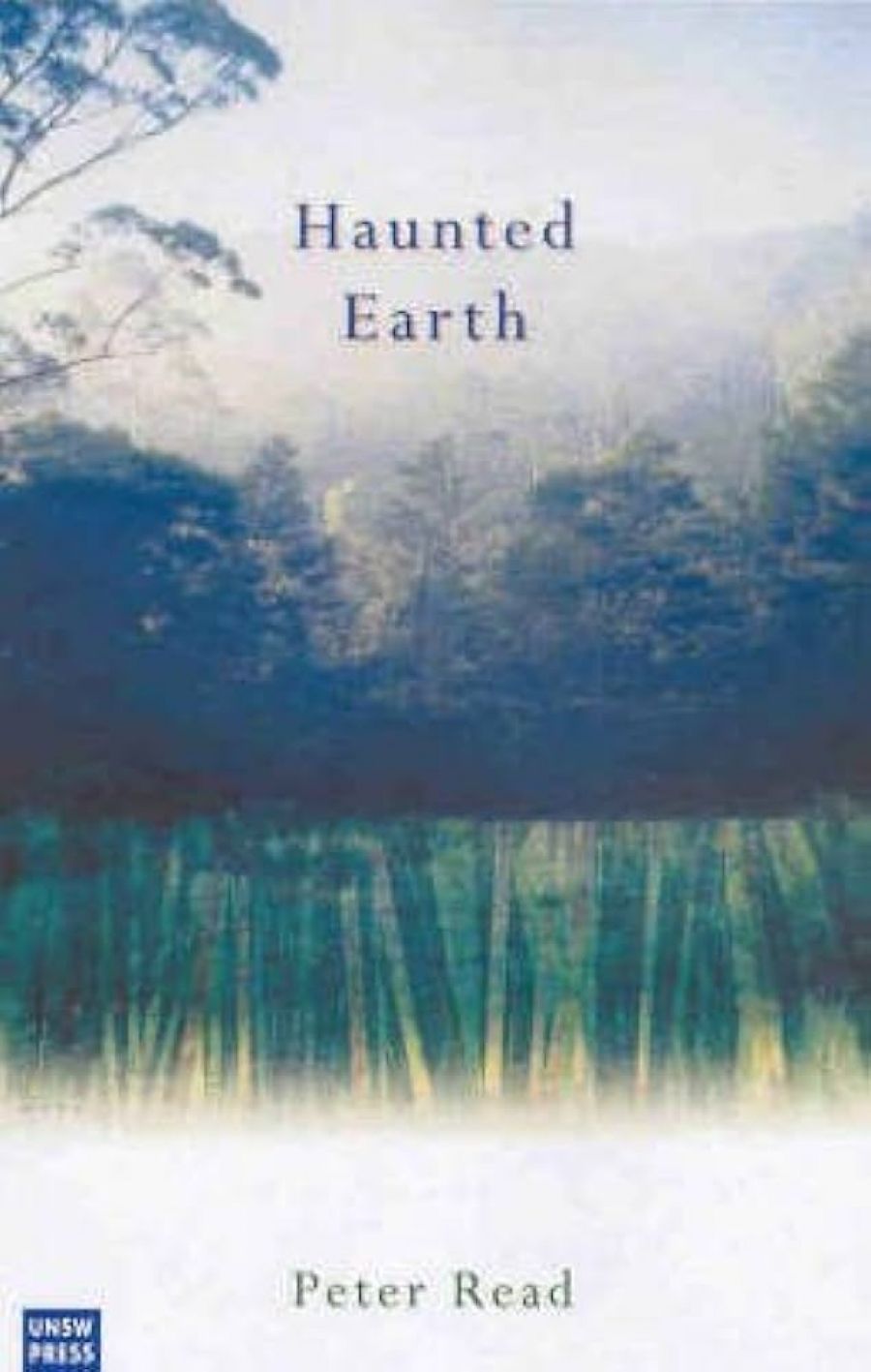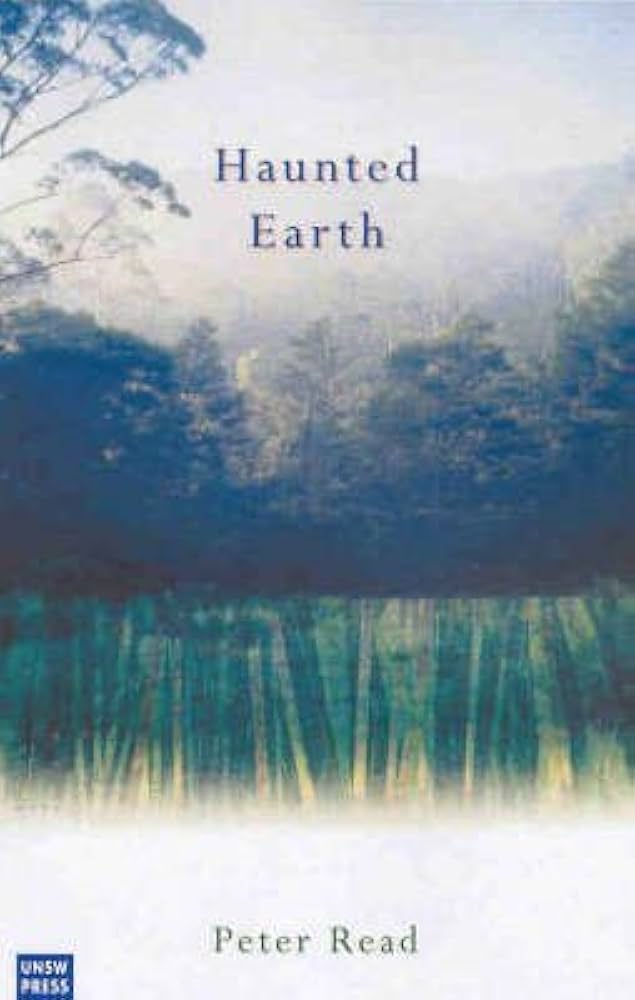
- Free Article: No
- Contents Category: Reviews
- Review Article: Yes
- Online Only: No
- Custom Highlight Text:
Haunted Earth is Peter Read’s third book in his series on Australian attachments to place. This work began with Returning to Nothing (1996), which explored how Australians feel about ‘lost’ places. Belonging (2000) investigated how non-indigenous Australians claim to belong and how they negotiate issues of cultural difference. It was overtly concerned with the ramifications that the establishment of Aboriginal history has had on national identity.
- Book 1 Title: Haunted Earth
- Book 1 Biblio: UNSW Press, $34.95 pb, 272 pp
- Book 1 Cover Small (400 x 600):

- Book 1 Cover (800 x 1200):

The book’s structure follows a twenty-four hour period, beginning with ‘Midnight’ and ending ‘Towards Midnight’. Read includes interviews, poetry, literature, non-fiction writing and his own experiences to explore the relationship between people and place. Each of the chapters is identified by a particular time, date and location. ‘Midnight’, for example, is subtitled ‘18 January 2002; Gore Hill Cemetery, Sydney’. Read is lurking in the cemetery, recording his impression of the place, and his lack of any sense of non-rational presences. Read believes that he doesn’t feel any particular spiritual presence in the Anglican cemetery because of his own cultural background. Those from different contexts are less susceptible to such a ‘retreat’ from spirituality.
Interestingly, in his accounts of inspirited places, it is predominantly an Aboriginal presence that haunts the present. The owner of a holiday rental business at Berowra wakes one night to the ghostly presence of an Aboriginal man. A farmer near Braidwood in New South Wales sees a group of Aboriginal people emerging from the bush, though there is no one there.
An immigrant from San Salvador has a similar experience when her son dies, but settler-descended Australians’ sense of inspirited places appears to be linked to the apprehension of Aboriginal presences. Further, Read holds that those ‘untroubled’ by places associated with the destruction of Aboriginal lives and culture are somehow inadequate. David, Read’s old school friend, believes that place has no memory: it is people who bring meaning to it. David left Australia at the start of the 1970s, before the growth in public awareness of Aboriginal history. Read concludes that ‘those unhaunted by the ghosts of the past have missed something profound’.
Although not made explicit, Read’s concentration in Haunted Earth appears to be more specific than a general exploration of spirits in Australian landscape. The question of how people negotiate the devastation to Aboriginal inhabitancy is repeatedly raised; making this the occasion for the book itself would have made the work more relevant.
When Read discusses the silo-based sound sculptures of Ros Bandt, he again makes this connection. In the surrounding area of one of the outmoded silos that Bandt works with, the Tjapwurrung people had mostly ‘disappeared’ at the end of the nineteenth century. Read writes: ‘Hold that Aboriginal culture in which, with wisdom, we all might have shared. Add the eighty years of soldier settler, grain and silo culture in which we might have shared also. Listen now for the aftersound.’ The past has some type of presence in place, whether or not this is classed as spiritual. In our present, he suggests, this inescapably involves an Aboriginal past.
Read finds other people’s lack of discomfort with the Aboriginal past surprising – and something to learn from. Of the woman who saw a group of Aboriginals materialise from the bush, he notes: ‘I had thought that the vision ... would be fundamental to her life on the farm. [But t]he longevity of shared space is perhaps more important still.’ He comes to an understanding of time and place as an ‘indivisible continuum’, in which we are located at a particular point. In an evocative image, he writes of this point as being at the crosswires of time and place. From this point, which is never fixed or still but always shifting, lines stretch outwards in various directions
In his final section, ‘Towards Midnight’, Read is in Burra where the Burra Charter was initially constructed. This charter gives ‘guidance for the conservation and management of place of cultural significance’. He argues that cultural and spiritual sites are different, and that the charter subsumes this difference within the broad banner of ‘culture’.
Sydney’s old Callan Park Mental Hospital, which some people believe to be haunted, is not listed; Read argues that it should be officially recognised as a significant site, because inspirited, beyond the Burra Charter. However, such promotion for the recognition of diversity in people’s attachments to place obscures the distinctions between genealogies of inspirited places as articulated with communal (i.e. Aboriginal) and individual agency (i.e. Western). Whilst a minor example, this issue of difference continues to unsettle nonindigenous attachment to place in Australia, as is suggested in the frequency here of Aboriginal people haunting nonindigenous people. The past presses in and transforms our present in locally specific ways that need to be discussed. With a sharper focus, Read’s book would have made an interesting contribution to this area.


Comments powered by CComment